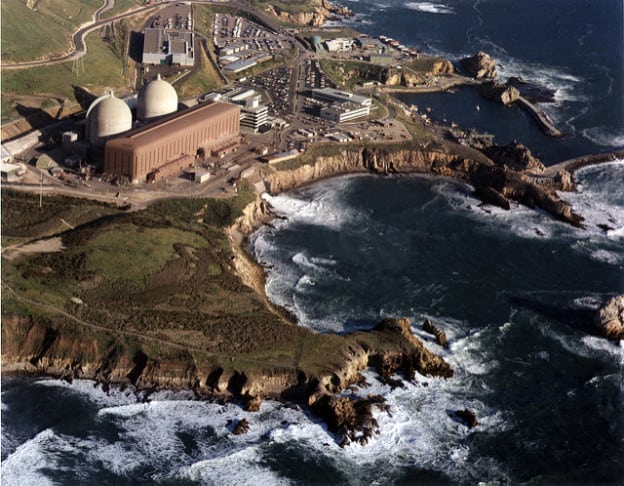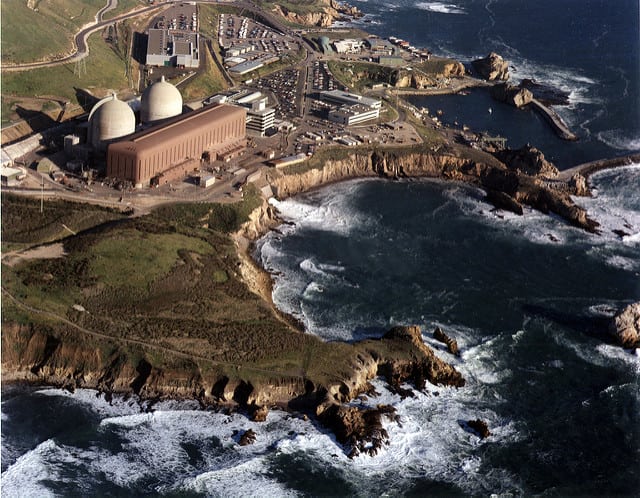DOE Grants First-Round Civil Nuclear Credit Award—$1.1B—to Diablo Canyon
Credit to Author: Sonal Patel| Date: Wed, 23 Nov 2022 16:12:24 +0000

The Department of Energy’s (DOE’s) first round of funding from its $6 billion Civil Nuclear Credit (CNC) Program is poised to go to Diablo Canyon Power Plant, California’s only operational nuclear plant.
Pacific Gas & Electric (PG&E), Diablo Canyon’s owner, could receive up to $1.1 billion in credits to extend the 2.2-GW plant’s operation for five years beyond its current license expiration in 2025 to bolster the state’s energy system reliability while additional renewable energy and carbon-free resources come online, the DOE announced on Nov. 21.
According to the DOE, the total credit award value of $1,100,520,444 will be contingent on the completion of an environmental review and negotiation of terms of a redemption agreement, which essentially specifies a megawatt-hour production commitment for four award years (2023–2026). For now, Diablo Canyon is set to receive a maximum credit value of up to $269 million for 2023, $267 million in 2024, $276 million in 2025, and $289 million in 2026. “The conditional award value represents the maximum credit value and corresponds to the difference between the projected costs plus risk and revenues,” the DOE explained.
Final award amounts, however, will “be determined following completion of each year of the award period, and amounts awarded will be based on actual costs,” PG&E underscored in a statement on Monday. “While there are key federal and state approvals remaining before us in this multi-year process, we remain focused on continuing to provide reliable, low-cost, carbon-free energy to the people of California, while safely operating one of the top-performing plants in the country,” said the utility’s CEO Patti Poppe.
First Award in a $6B Contest
The DOE’s conditional selection is the first of a much-watched contest for the federal funding designated by the November 2021–enacted Infrastructure Investment and Jobs Act (IIJA) to keep open commercial nuclear reactors that are at risk of closure owing to economic reasons. The law outlines specific allocations of $1.2 billion per year for fiscal years 2022 to 2026. The funds will be available until spent or can be allocated until the end of fiscal year 2031 (on Sept. 30, 2031).
But while the DOE formally opened the CNC contest on April 22, it revised its eligibility criteria for the first-award cycle on June 30 to respond to a request for adjustment from the California governor’s office to better address Diablo Canyon’s “unique circumstances.” The DOE’s changes—which clarified how it interpreted whether a reactor met IIJA eligibility requirements that a reactor only qualifies for CNC credits if it “competes in a competitive electricity market”—drew mixed reactions from an array of stakeholders from the power sector.
PSEG Nuclear, which operates the Salem and Hope Creek Nuclear Generating Stations in Lower Alloways Creek, New Jersey, and is a part owner of the Peach Bottom Nuclear Plant in Pennsylvania—all plants that compete in PJM Interconnection, for example, urged the DOE to instead “rethink the timing of the CNC Program to allow all reactors that truly compete in a competitive electricity market to immediately apply for Credits.” The company suggested that because Diablo Canyon “receives a majority of its revenues outside a competitive market is insulated from those economic pressures and should not be eligible to apply.”
The DOE’s first CNC award cycle prioritized reactors that are most at risk of imminent closure or had already announced their intention to cease operations before Sept. 30, 2026. Only one other nuclear reactor—Holtec International’s now-shuttered 800-MW Palisades nuclear power plant in Michigan—had confirmed it submitted a federal grant application to the DOE’s CNC program. The proposal had backing from Michigan Gov. Gretchen Whitmer.
On Nov. 18, however, Holtec spokesperson Pat O’Brien confirmed the DOE denied its request for funds. Permanent closure of 50-year-old plant was “not the outcome many had hoped for,” he said. “We entered this process committed to working with our federal, state, and community partners to see if the plant could be repowered to return to service as a provider of safe, reliable, and carbon-free generation,” he added. “We fully understood that what we were attempting to do, re-starting a shuttered nuclear plant, would be both a challenge and a first for the nuclear industry.”
DOE now anticipates launching the next award cycle in January 2023. The second CNC award cycle will prioritize reactors “that are projected to shut down due to economic factors within the next four years.” The DOE is expected to begin accepting applications for the second cycle of CNC funding in January 2023.
A Major Boost for Diablo Canyon
The DOE’s conditional selection of PG&E, meanwhile, marks a notable reversal for Diablo Canyon’s near-term prospects, and possibly over the long term.
PG&E in June 2016 formally announced it would shutter the 1,138-MW Unit 1 and the 1,151-MW Unit 2 upon the expiration of the reactors’ operating licenses—November 2024 for Unit 1 and August 2025 for Unit 2. The units, both Westinghouse pressurized water reactor units, began operation in 1985 and 1986. At the time, PG&E cited challenges of managing “over-generation and intermittency conditions under a resource portfolio increasingly influenced by solar and wind production,” as well as potential costs for retrofits so the station could comply with a May 2010 California Water Resources Control Board policy restricting once-through cooling (OTC) systems for all the state’s water consuming power plants. Nuclear experts at think tank the Breakthrough Institute, however, suggest PG&E negotiated an agreement with anti-nuclear environmental groups based on a flawed study that until recently was broadly accepted by California’s legislators and regulators.

While PG&E has remained largely quiet as the debate about its voluntary plan to shutter the reactors has raged on, recent backing from California’s government to keep the plant open to bolster the state’s energy security prompted the company to jump into action.
After Gov. Gavin Newsom’s administration in April 2022 acknowledged the retirement of the nuclear plant may adversely affect California’s stretched energy system, the governor in August proposed a plan, which in part included giving PG&E a $1.4 billion loan. A less ambitious version of that proposal was enshrined in state law with the passage on Sept. 1 of Senate Bill 846. The measure effectively authorized the $1.4 billion loan from the Department of Water Resources to keep Diablo Canyon open until at least 2030.
PG&E filed its application for the CNC funding on Sept. 2, the same day Gov. Newsom signed SB 846 into law. “SB 846 further directed PG&E to pursue funds from DOE, and any other potentially available federal funds, to pay back the loan and lower costs for customers should the plant’s operating license be extended,” the company said in a statement on Monday.
The San Luis Obispo County plant currently provides “approximately 17% of California’s zero-carbon electricity supply and 8.6% of the state’s total electricity supply,” the utility said. An extension of five years beyond its current license expiration in 2025 could allow the plant to “be used to improve statewide energy system reliability and reduce greenhouse gas emissions while additional renewable energy and carbon-free resources come online,” it said.
Without Senate Bill 846, PG&E’s alternative “would have been for us and other load-serving entities in California to procure more expensive baseload clean power to replace what is today over 8% of all of California’s energy consumed, provided annually by Diablo Canyon,” PG&E’s head Poppe said during an Oct. 27 earnings call. “Replacing this power has proven challenging given clean energy supply constraints, and we estimate that this law will save customers several hundred million dollars relative to other potential baseload solutions.”
PG&E Steps Up 20-Year Licensing Renewal Effort
However, Poppe has acknowledged ensuring extended operations at the plant will require much work. That will include securing casks and fuel, as well as navigating permitting and relicensing of the facility are complex.
On Oct. 31, PG&E took its first step of steps, filing a letter with the Nuclear Regulatory Commission, officially requesting that the agency result its review of the utility’s 2009-submitted license renewable application for Diablo Canyon Units 1 and 2.
The company is looking to extend the nuclear plant’s licenses for another 20 years. “Although the energy mix that will be in place after Diablo Canyon’s current licenses have expired has yet to be determined, extending Diablo Canyon’s licenses for another 20 years through 2044 and 2045 for Units 1 and 2 respectively, will help ensure California will be able to meet the state’s future energy demands with affordable, baseload, clean electricity, while allowing time for newer technologies to more fully develop,” it said.
The investment is prudent, PG&E argues. “Increasing investment in renewable energy sources with a stronger focus on efficiency are important goals, but not enough to ensure we have enough abundant and affordable electricity to power California’s massive energy infrastructure without adding significant amounts of greenhouse gases into the environment,” it said. “Nuclear power is the only realistic option available for generating clean, baseload power, and that is why countries like United Kingdom, France, Italy, Japan and China are investing significant public funds into building their own fleets of nuclear power plants while also backing the development of alternative energy sources.”
It underscored: “In fact, even when renewable power technologies are fully developed and ready for widespread implementation, Californians will still need an abundant supply of dependable baseload power for meeting increasing demands, minimizing severe rate increases and ensuring the reliability of the state’s electricity grid.”
—Sonal Patel is a POWER senior associate editor (@sonalcpatel, @POWERmagazine).
The post DOE Grants First-Round Civil Nuclear Credit Award—$1.1B—to Diablo Canyon appeared first on POWER Magazine.